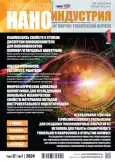Scanning probe microscopy of Substantia Nigra
- Authors: Akhmetova A.I.1,2, Sovetnikov T.O.1,2, Zorikova E.O.3, Yaminsky I.V.1,2
-
Affiliations:
- Lomonosov Moscow State University
- Advanced Technologies Center
- Weizmann Institute of Science
- Issue: Vol 17, No 1 (2024)
- Pages: 26-31
- Section: Nanotechnologies
- URL: https://journals.eco-vector.com/1993-8578/article/view/627372
- DOI: https://doi.org/10.22184/1993-8578.2023.17.1.26.31
- ID: 627372
Cite item
Abstract
The response of cells to mechanical signals plays a key role in biological processes such as organ development, tissue regeneration, aging and cancer development. Changes in mechanical properties, including stiffness and viscosity, show how cells and tissues react to stress and how their biological functions depend on it. Scanning probe microscopy (SPM) is a versatile tool for quantitative characterization of the mechanical properties of tissues and cells in vivo. Data on the mechanical properties of biological objects obtained using atomic force and capillary microscopy can be associated with biological processes and pathologies in tissues.
Full Text
About the authors
A. I. Akhmetova
Lomonosov Moscow State University; Advanced Technologies Center
Email: yaminsky@nanoscopy.ru
ORCID iD: 0000-0002-5115-8030
Cand. of Sci. (Physics and Mathematics), Junior Researcher, Physical department
Russian Federation, Moscow; MoscowT. O. Sovetnikov
Lomonosov Moscow State University; Advanced Technologies Center
Email: yaminsky@nanoscopy.ru
ORCID iD: 0000-0001-6541-8932
Master, Physical department, Leading Engineer
Russian Federation, Moscow; MoscowE. O. Zorikova
Weizmann Institute of Science
Email: yaminsky@nanoscopy.ru
ORCID iD: 0009-0001-1086-6399
Post Graduate, Biophysicist
Israel, RehovotI. V. Yaminsky
Lomonosov Moscow State University; Advanced Technologies Center
Author for correspondence.
Email: yaminsky@nanoscopy.ru
ORCID iD: 0000-0001-8731-3947
Doct. of Sci. (Physics and Mathematics), Prof., Director
Russian Federation, Moscow; MoscowReferences
- Cho D.H., Aguayo S., Cartagena-Rivera A.X. Atomic force microscopy-mediated mechanobiological profiling of complex human tissues. Biomaterials. Elsevier Ltd. Biomaterials, 303, (2023) P. 122389. https://doi.org/10.1016/j.biomaterials.2023.122389
- Benech J.C., Romanelli G. Atomic force microscopy indentation for nanomechanical characterization of live pathological cardiovascular/heart tissue and cells, Micron 158 (2022), P. 103287. https://doi.org/10.1016/j.micron.2022.103287
- Akhmetova A.I., Sovetnikov T.O., Maksimova N.E., Terentyev A.D., Uzhegov A.A., Yaminsky I.V. The heart of the capillary microscope. NANOINDUSTRY. Vol. 16. No. 7–8 (2023), PP. 444–448. https://doi.org/ 10.22184/1993-8578.2023.16.7-8.444.448
- Pleskova S.N, Bezrukov N.A., Gorshkova E.N., Bobyk S.Z., Lazarenko E.V. Exploring the Process of Neutrophil Transendothelial Migration Using Scanning Ion-Conductance Microscopy. Cells. (2023) 12(13):1806. https://doi.org/10.3390/cells12131806
- Solares S.D., Cartagena-Rivera A.X., Beilstein J. Nanotechnol. (2022) Vol. 13. PP. 1483–1489. https://doi.org/10.3762/bjnano.13.122
- Sovetnikov T.O., Akhmetova A.I., Maksimova N.E., Terent’ev A.D., Evtushenko G.S., Rybakov Y.L., Gukasov V.M., Yaminskii I.V. Characteristics of the use of scanning capillary microscopy in biomedical research. Bio-Medical Engineering. Vol. 57, 4 (2023). PP. 250–253. https://doi.org/10.1007/s10527-023-10309-4
- Akhmetova A.I., Yaminsky I.V., Sovetnikov T.O. FemtoScan Online: 3D visualization and processing of bionanoscopy data. NANOINDUSTRY. Vol. 16. No. 7–8 (2023). PP. 450–455. https://doi.org/10.22184/1993-8578.2023.16.7-8.450.455
- Rourk J.C. Indication of quantum mechanical electron transport in human Substantia nigra tissue from conductive atomic force microscopy analysis. Biosystems. Vol. 179 (2019). PP. 30–38. https://doi.org/10.1016/j.biosystems.2019.02.003
Supplementary files







